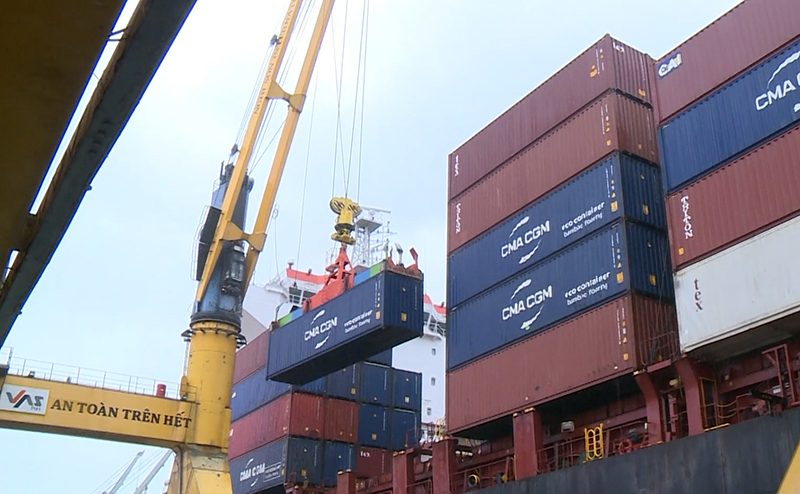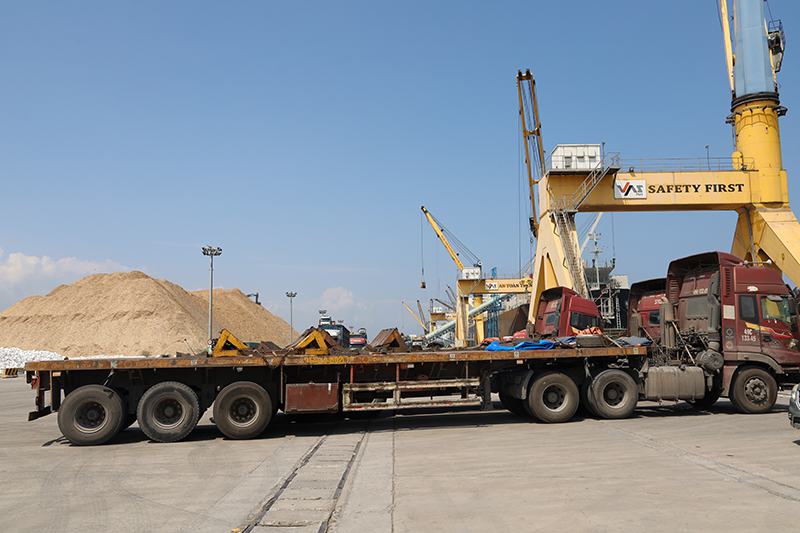
Exporting goods by container through Nghi Son Port.
Strategic advantages and strong incentive policies
Nghi Son seaport has many advantages in terms of natural conditions and geographical location. Located in the center of the North Central region, adjacent to National Highway 1A, the North-South railway and the North-South expressway, the port is easily connected to industrial parks and production centers inside and outside the province. The port is capable of receiving ships with a capacity of 70,000 DWT - 100,000 DWT and is one of the few ports in the Central region that can handle large container ships.
Nghi Son Seaport System with a planned 52 berths and wharf areas has been invested by many resources, including 10 container berths, 22 general berths, 20 specialized berths and wharf areas. Of these, 25 berths have been put into operation, including 13 general berths and 12 specialized berths. In the general port area, 7 berths are continuing to be invested in and constructed; including 4 berths of VAS Nghi Son Group Joint Stock Company; 2 berths of Long Son Industrial Company Limited; 1 berth of Quang Trung Company Limited. The container port area has currently approved the investment policy for VAS Nghi Son Group Joint Stock Company with 4 berths and Long Son Company Limited with 4 berths; in which, berth No. 3 of Long Son Company Limited is being built to soon form the first specialized container port in Thanh Hoa.
In order to encourage businesses to use port services, especially container transport, Thanh Hoa province has issued many direct and indirect support policies. Most recently, Resolution No. 248/2022/NQ-HDND dated July 13, 2022 of the Provincial People's Council (referred to as Resolution 248) has increased the support level and expanded the beneficiaries of the policy.
Accordingly, Thanh Hoa province has added a policy to support domestic container transport vehicles at a rate of 300 million VND/trip; increased the support level for international sea transport vehicles via Nghi Son Port to 500 million VND/trip (an increase of 300 million VND/trip compared to the previous support policy according to Resolution 166/2019/NQ-HDND dated April 4, 2019 of the Provincial People's Council). At the same time, many support policies have been added to support enterprises, organizations and individuals to import and export goods by container via Nghi Son Port for goods with and without declarations at the Thanh Hoa Provincial Customs Department. Enterprises, organizations and individuals importing and exporting goods by container via Nghi Son Port are supported with 2 million VND/20-foot container and 3 million VND/40-foot container when declaring at Thanh Hoa Customs; Support 700,000 VND/20-foot container and 1 million VND/40-foot container when businesses do not open a declaration at Thanh Hoa Customs.
This is a big step forward in concretizing the policy of developing import and export through Nghi Son Port.
Modest results
Currently, the volume of goods passing through Thanh Hoa Seaport has far exceeded the forecast scenarios in the detailed planning of the North Central Seaport Group (Group 2) for the period up to 2020, with a vision to 2030 approved by the Ministry of Transport. According to statistics from the Vietnam Maritime Administration, in 2024, the volume of goods passing through Thanh Hoa seaport will reach 56.27 million tons. Of this total volume, goods exported through Nghi Son Port account for 99.8% with 56.14 million tons. However, in the structure of goods sources, dry and bulk cargo account for 64.5%; liquid cargo accounts for 35%; container cargo only reaches 0.27 million tons (equivalent to 21,061 TEU).

The structure of goods exported through Nghi Son Port is currently mainly white stone, wood chips..., items with low added value.
According to the Management Board of Nghi Son Economic Zone and Industrial Zones of Thanh Hoa province, since implementing the policy of supporting and stimulating import and export activities by container, Nghi Son Port has had 3 international shipping lines opening container transport routes through the port, contributing to expanding the logistics network, creating favorable conditions for businesses in Thanh Hoa and neighboring areas such as Nghe An and Ha Tinh. Many provinces and cities have come to learn about the model of supporting import and export through the port to learn from experience.
However, according to the unit's assessment, the frequency of ships arriving at the port is currently only about 10 days/trip, which is quite modest compared to actual demand. Along with that, the structure of imported and exported goods at Nghi Son Port is currently unbalanced. The main export items are white stone, stone powder, cassava chips, paper - items with low added value. For imported goods, the amount of containers passing through the port is mainly empty shells or low-value goods such as scrap, scrap iron, leading to insignificant budget revenue from containers. Accordingly, the budget revenue from imported and exported goods by container through Nghi Son Port since Resolution 248 took effect has only reached 24 billion VND.
In addition to the objective reason that many FDI enterprises are still loyal to traditional ports such as Hai Phong, Cai Lan, Da Nang due to long-term contracts with international logistics partners, many enterprises are still somewhat concerned about the stability and lack of professionalism in container services at Nghi Son Port. Accordingly, Nghi Son does not have a dedicated container wharf in operation. Container exploitation activities are still taking advantage of the general port, causing long loading and unloading times and high costs. Along with that, the lack of a dedicated port in operation causes a lack of specialized machinery and equipment. The warehouse system is not yet synchronized, there is no qualified container yard for long-term storage of goods. Along with that, the logistics ecosystem in the Nghi Son Port area is still in its infancy. There are no enterprises investing in specialized road container transport, there is a lack of regional logistics centers, there are no ICDs, bonded warehouses or large-scale cargo gathering points. This makes domestic transportation costs still high, not creating a clear advantage compared to other seaports.
Currently, 8/10 planned container ports have investors; however, only Terminal No. 3 of Long Son Company Limited is currently being invested in and constructed. The investor plans to build Terminal No. 5 and Terminal No. 6 and a logistics development area of 28.8 hectares in Phase 2, which will be put into operation by the end of 2030. With a transit capacity of 1 to 1.2 million containers with a volume of 40m3/year, Long Son Container Port will be one of the 10 largest container ports in Vietnam when it comes into operation. Together with the modern seaport system invested in Nghi Son Economic Zone such as Nghi Son International Port, PTSC Nghi Son Port will form a continuous seaport network, capable of receiving large and super-large cargo ships, with many types of oversized and overweight goods conveniently entering and exiting to load and unload goods. This is also a favorable condition to turn Nghi Son into one of the largest seaport centers in the country.
In the long term, in order for Nghi Son Port to promote its role as the province's import-export center, a comprehensive strategy and synchronous, long-term solutions are needed, such as modernizing the loading and unloading system and expanding the area of warehouses and container yards; at the same time, attracting investment in the logistics sector with ICD dry port projects, regional logistics centers, container transportation services, bonded warehouses, etc. Along with that, stimulus policies need to be maintained long-term and specifically for shipping lines, logistics enterprises and large cargo owners to encourage a sustainable shift in container import-export activities to Nghi Son Port.